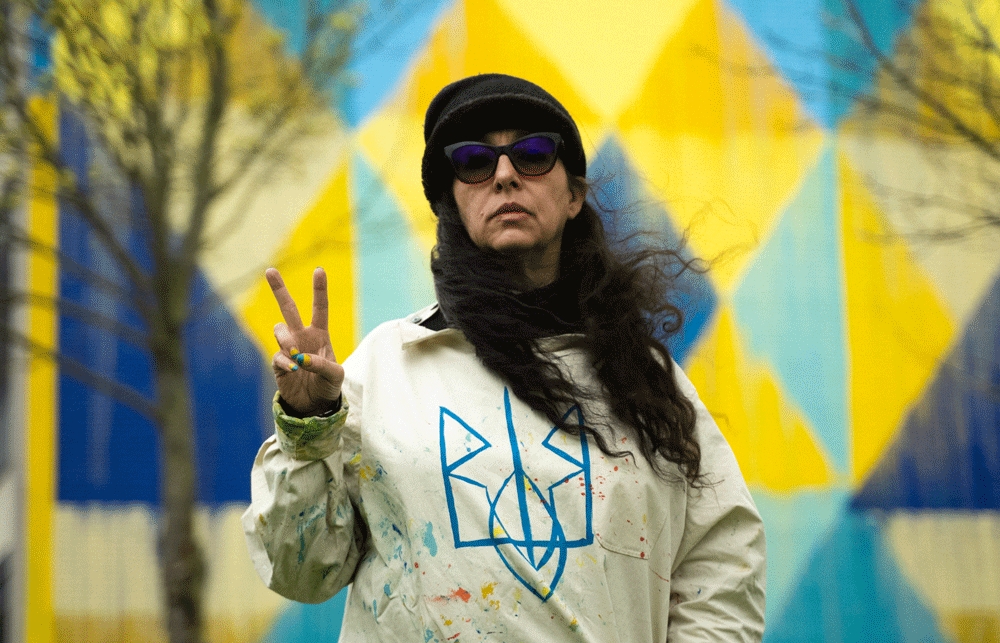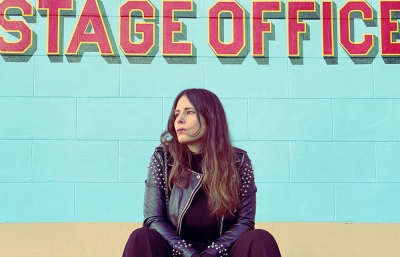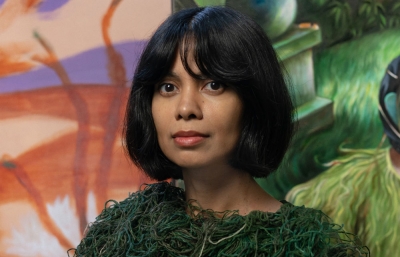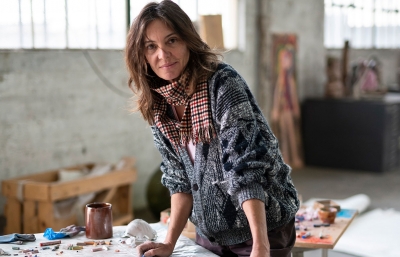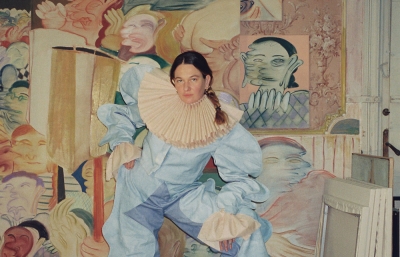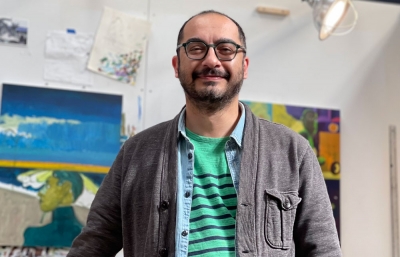Maya Hayuk
Heritage & Hope
Interview and portrait by Doug Gillen // Introduction by Evan Pricco
Accidents happen—on purpose. I’ve heard that phrase before and it feels reasonable, yet abstract enough to inform daily life. Ukrainian-American Maya Hayuk’s paintings are an elaborate stream of consciousness made in a valiant attempt to contain an accident, and in the process, feel absolute and free. For decades, she has channeled the folk traditions of outsider art with graffiti and street art. Her studio paintings and murals feel improvised, but there is a narrative thread that runs throughout: what is our existence if not chance, what is creativity if not a blurring of the lines between process and bursts of unchained energy?
ElevenEleven, or 11:11, is symbolic. It was also the name of her last solo show in San Francisco in the Fall of 2021. Some say it's an indication of cosmic enlightenment, others use the time to signify making a wish. The conclusion amongst numerologists and spiritualists is that it's a moment when we are our most open, or consciousness is most exposed. You may find time arbitrary, and most artists probably find time to be so when they are in the depths of creating. When we sat down with Maya Hayuk in Belgium this past spring during The Crystal Ship festival, we found her the rare artist who freely takes this openness out in public. Her murals and work as a Barnstormer transformed the American landscape into something of a dizzyingly abstract dream. It opened minds to the possibility of a new kind of muralism, something both folk and surreal. But this time, when we spoke with Maya, we spoke about Ukraine, about the importance of art as a symbol of peace, as a tool of understanding and protest, as an instrument of passion and belief, and enlightenment in a completely different way.

Before we looked at outsider art as a force in the contemporary art world, there was Maya, finding traditions in her native Ukraine, remixing and reimagining how these directions could become something wholly herself. You can see in each canvas a compulsive mark-making, as well as something ancient. Maybe it's a necessity to let the paint drip while moving to the next stroke? Maybe motion is the driving factor? Whatever it may be, Maya is a conduit to something greater than just art in her unbridled way of perceiving the world.
Maya can sew with paint. Colors interlock, blend, mix, twirl and bind themselves in bright interlocking pieces of brightness. They are handmade electricity, unpredictable but universal. The interconnectivity of overlapping colors overlapping speaks to our humanity. In an era of turmoil and chaotic notions of space and place, Maya hopes to bring our differences together, enforcing our commonalities. She makes powerful work for dynamic times. When we look back on this era, we may see puzzles unsolved and alliances broken, but also a universal need to build bridges of solidarity and community. Accidents happen on purpose, and Maya Hayuk is painting a path of joy and compassion. —Evan Pricco
Doug Gillen: Let's discuss the wall that you just created here in Belgium and what you had in mind.
Maya Hayuk: I don't know how to answer that. I think, just straight up, as soon as the war broke out in Ukraine, the lead up to it is a lifetime of knowing that someday this was going to happen. Not if it's going to happen, but just a matter of when. So for the months leading up to it, my family and I, our friends, were all very aware that it was coming. It was going to happen the day after the Olympics. It was so perfectly timed. So it's not that I made a conscious choice. Or I guess I did make a conscious choice. It's just the choice was, do I do something for me, about me, and the community? Or am I working for peace in Ukraine? It's so much bigger than me, yet completely outside of me. So it's like my duty and honor to work on making paintings that resonate about peace in Ukraine.
I do want to say that I hope that art is something accessible for anyone, the way you listen to music without having to know who the artist is, or why it exists, or what the backstory is. Art is visual. Art is the same. You watch movies; you don't know who the director or the producer necessarily are, or the names of actors necessarily. In this case, for me right now, it's going to be a very long time before I'm not working towards visuals and public murals that point to Ukraine, genocide, and peace. So this particular mural, it's on the side of a school, a building that was probably built in the 1970s. It's a typical kind of proto-Bauhaus-y, modern 1970s building with a big slab of a wall. When we started painting it, I just outlined a few spray painted guidelines to have, I guess, essentially as a grid. The background had already been painted as a Ukrainian flag, which I requested. So it was sweet that it ran just as a Ukrainian flag for a good two weeks before I arrived, or before my team and I arrived.
The painting is very geometric and super minimal for me. There are no outlines. It's a bunch of shapes puzzled together, mostly triangles, and diamonds, and such, based off of this Ukrainian Trident image, this Tryzub. It looks like it's deconstructed somehow. As I was painting, it started reminding me of a Northern European, particularly Belgian, modernism, when people started using the word modernism, that has that kind of geometry, that appeal. In fact, the actual layout of the shapes are all values of blue and yellow, with no variation, no black, no white, no red, pinks, nothing. It's just blue and yellow, and their friends. I actually looked at it and was, like, "This would be amazing as a tiled artwork." And it would then be really quite reminiscent of something from the 1960s, I think, or even a socialist kind of vibe. So that's that. It's very drippy, as usual. One is super drippy and looks kind of like the backside of a tapestry that was hand woven and had a lot of extra strings and weaving, weaving about.
And that’s why we ask the artists to describe their work. I love the way you put it all together.
And that was so hard for me to do. I'm staring off into the distance and thinking, "What is it?" I'm going past my third week of being in Europe now, and just saturating my face with so much stuff.

I know that for many of your murals the actual design isn't really finalized until you're there in front of the wall. Was that the scenario for this project?
Oh, 100%. I mean, I was up in the cherry picker doing the top parts of the mural, and I have to say we actually painted it in two days because my crew, John and Paul, aka PPM, are machines and we are psychic together. We've been working as a team for years now and have this process really dialed in. It's really fun and very, very strenuous. It's like I feel very athletic when I'm working. So having the confidence of this incredibly strong machine gives me a lot of room to be able to make snap decisions, because before, part of the reason I didn't work with assistants is because I didn't know what I was doing. I mean, I really enjoyed not knowing what I was doing, and I would step back, and try to figure it out.
Now, in this case, it's really, really cold. We've had days where the rain is practically moving sideways. Then it's hailing, and then it's snowing, and then it's raining again, so we had to figure out how to do this mural as quickly as possible before the rain would potentially wash it off. I was making decisions about how it was going to be finished until the last moment of completion. But that's the fun of it. I'm making a huge drawing on a wall, then stepping back from this huge wall into the middle of a park, and I’m like, "Oh, those two colors don't resonate with each other. Okay. Well, push it this way or that.”
We haven’t talked about your Ukrainian heritage and though this is not integral to your identity as a human being, it is very much in the visual language you have created at the center of your work. Did you embrace that traditional craft, even when as a kid?
My parents raised my brother and me to speak Ukrainian first, English second. As far as art, my grandmothers both taught me embroidery and pysanky, a boutique method of Easter egg making that goes back way to pagan times. I loved those forms of craft, but they were so precise and meticulous that, over time, I was not exactly doing it the way I was supposed to be doing it. I always drew as a kid and I always knew that I liked drawing more than anybody else because whenever I'd have play dates, invariably my friends would be like, "Is there something else we could do?" And I was like, “Can you name something that's more fun than this?”
Flash-forward to discovering that the world of art history is predominantly white male, dead white male-dominated, and luckily I learned, through the lens of Ukrainian art, that a lot of Ukrainian artists are women, and a lot of artists are women. I got really fascinated with this idea that women all over the world tend to be the ones who make the crafts, even though these are usually written off as, “It’s just decorative. It's for the home. It's not art." But there are so many hidden languages, coding, and message-making between women from one household to another, from one generation to another that it's deeply entrenched in these very… I don't know, they're almost like digital code. They're like ones and zeros made into patterns. And I always wondered too, "How come men in the museums make a painting, and then sign their name at the bottom, and when a woman makes any kind of craft, her name is not associated with it 99% of the time?” And she certainly doesn't sign it, but women each have their own way of making things. So I can distinguish my grandmother's embroidery from other peoples. But they do really stick to a really strict code.
I think what I have been most fascinated by lately is taking those patterns and blowing them up, scaling them up massively, or even repurposing, say, my Wynwood mural or my Bowery Wall. A lot of the things I've been making that are super, super big are actually zoomed into certain areas from those specific walls. So the bigger the wall, the more minimal it's going to be. The bigger the wall, the more I'm going to edit the language down.

Do you actually get an embroidered piece that you zoom into and then create from that? How does that process work? Is it a digital composition where you layer things on top of each other first? Can you talk about that?
Wow! You're totally giving me ideas of ways to draw, or ways to work. I draw a lot, a fair amount; so I drew out this design, or the spine for this design, once we had already seen the wall. It was the day we came up here from France on the train, I sketched out what the framework was. Have I taken a piece of my grandmother's embroidery and zoomed in on it? I wish I could say yes, but I haven't. I have used it and the technique as a source of inspiration.
My mother is a great collector of Ukrainian embroidery. And, oh man, she has some unbelievable pieces that are, as you can imagine, incredibly regional. The kind of embroidery you wear when you go to a Ukrainian event, let's say, represents where you're from, these specific languages. There are some incredibly beautiful maps of Ukraine that reflect the motif of that region.
When you first came out onto the street were you trying to sort of join the party, or were you trying to do something different? Was it just graffiti that you were seeing? In fact, how do you feel about the term street art?
I will say, there's only one term for this form of art that's worse than street art. And that's what's said in Europe and the rest of the world, which is urban art. Urban, like Keith Urban. Urban, the hell does that mean? We work outside. I moved to San Francisco in 1991, and then again in 1996. I was there for two years the first time, and it was a sleepy awesome place to live, super cheap rent, worked in a restaurant, worked in a comedy club, bartended, whatever. The second time I stayed until 2002. But the thing that got me immediately, I'd say the first thing I remember seeing where I was, like, "Whoa," was Reminisce's horses. Her horses are amazingly spray painted, so beautiful. Just trotting around the corner, jumping over things. And Barry McGee's twisters, seeing those. Then I started noticing Margaret Kilgallen's work, then Alicia McCarthy, Chris Johanson, people whose names I didn't know, but who were doing really interesting things on the street. Alicia did this really cool thing where there would be buffs over graffiti; you know how the buff color is never the exact same color as the wall? She was taking yet another color that was in the same realm, and building out images from really abstracted images. Out of these buffs that you would not necessarily notice, but they were there and they were really beautiful.
I also saw it immediately as super egalitarian, very gender spectrum diverse. And so that conversation about, "Girls are trying to catch up to the boys." That wasn't even a fucking conversation because we had already obliterated that stupid fucking myth.
What convinced you to say yes to festivals? You said it's not something you do very often. What suddenly gave them enough appeal that you thought, "Yeah, actually, that does sound like a fun one to do."
To be honest, I'm not invited to that many festivals. I'm not exactly sure why, but, for me, it has to be sustainable and viable. It has to honor workers' rights. It has to be something that values the artist and isn't just like, "We're going to do 200 murals in Miami over the course of three days and pay you no money." It has to be a nice wall, too. And I've been invited to do some incredible festivals, but the wall is just bunk, and I'm like, "I'm not inspired on any level to do this."
I will choose a festival if it's reasonable, viable, and it can support my whole crew. I have to work with my people because we're a trio, at the very least, and we might be more like five or six people if necessary. So there are certain things I can't skimp on, like equal pay, a safe environment, good materials, good production, comfortable places to live, and good food. Maybe that's why I'm not being invited to festivals, because I say shit like that.
You're not asking for limos to pick you up and for bottles of Cristal.
I'm asking for, what are they called? The new Volvo electric car to pick me up, ha.

Looking back on your career, without thinking about it, what makes you most proud?
I guess, this moment. I'm psyched. I'm really glad that I get to do what I do, and that I can hopefully keep growing stronger and better at it. And honestly, every mural I'm painting, it's my favorite one while I'm painting it. I have so many stories of each one, and a lot of them have a lot of really dark... I have a lot of stories that sound like I'm griping, or bitching, or whatever, but I tend to remember some really brutal scenarios of just barely pulling something off. I'm glad that I'm working with the people I work with. And I'm glad that... Shout out to John and PPM. I'm really just lucky. And so I guess the future is hopefully my best moment. I'm still figuring it out.
This interview was conducted at the The Crystal Ship festival in Oostende, Belgium. For more information, follow Maya at @mayahayuk

